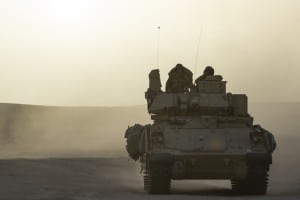The maximum value for contracts awarded to each vendor selected for the detailed design and prototype build phases of the Army’s Optionally Manned Fighting Vehicle (OMFV) program is expected to be $903 million if all options are exercised, Army officials told reporters Tuesday.
“I would say the bulk of the investment actually happens when we get to the transition to Phase 4 [prototype build], because it’s very expensive to build prototypes and then subsequently test. So if you look at our profile, it should be a little bit lower in the first year, the 18 months of Phase 3 [detailed design] and then it’ll spike as we execute prototype build,” Brig Gen. Glenn Dean, program executive officer for ground combat systems, said in response to a question on how the potential contract value could be allocated between the two phases.

Dean and Maj. Gen. Ross Coffman, director of the Next-Generation Combat Vehicle Cross Functional Team, provided additional details on the next stages of the OMFV competition following the release of the final Request of Proposals last Friday for Phase 3 and 4 of the Bradley replacement program (Defense Daily, July 1).
The final RFP affirmed the Army’s plans to award up to three contracts for Phase 3 and 4, with Dean noting there may be vendors interested in the open competition who are not currently participating in the program.
“That’s because we’ve continued to share the updated requirements and specifications all along the way in Phase 2, so that if another outside vendor, and there are some combat vehicle Original Equipment Manufacturers, non-U.S., that are not participating in the competition and have continued to follow the program, may choose to throw their hat in the ring and we wanted to keep that option open. Potentially, we see more than our five Phase 2 vendors competing,” Dean said.
Dean said interested vendors not currently in the OMFV program are kept in the loop on vehicle architecture updates through the National Advanced Mobility Consortium and specification updates accessible to vetted companies posted on SAM.gov, while noting they “don’t get the direct benefit of the dialogue around their concept” as those currently in participating in Phase 2.
“The companies that I’ve talked to, and I’ve talked to a couple of major primes who are not in the current design phase, I know they’re following along. Some of them have concepts that are very close to what we’ve arrived at with the current design concepts in Phase 2. In fact, I won’t name names but there was one pretty close sitting at Eurosatory, the defense trade show in Paris in mid-June, from somebody who wasn’t participating,” Dean said.
Last July, the Army awarded nearly $300 million in contracts to five teams led by General Dynamics Land Systems [GD], Oshkosh Defense [OSK], BAE Systems, Rheinmetall and armor supplier Point Blank Enterprises for OMFV Phase 2 to work on refining their platform concepts over a period of 15 months (Defense Daily, July 23 2021).
“Each designer has taken a different approach to the details but, in general, we’re seeing them in about the same size range, we’re seeing them in about the same level of protection and lethality, as you would expect as we converge on specifications based on the back and forth feedback,” Dean said of the OMFV concepts being worked through Phase 2, which is set to conclude in December before Phase 3 and 4 awards are made 60 to 90 days later.
Dean and Coffman noted the Army is now on its fourth version of its vehicle specifications for OMFV, with plans to lock in requirements between Phases 3 and 4 heading into the prototype build process.
“The iteration back and forth between industry and government has been unprecedented. We have several thousand comments from industry on the proposed performance specifications or requirements. This has allowed us to iterate. This has allowed industry to really have a transparent view into the government’s thoughts as we’ve refined these, so they can keep pace. We didn’t drop a telephone book of requirements from behind a curtain. Industry has been with us step-by-step, shoulder-to-shoulder on each of these requirements,” Coffman.
Dean said proposals for OMFV Phase 3 and 4 will be broadly evaluated on projects performance of proposed systems at the digital level for lethality, protection and mobility, the vendors’ approach to open architecture and assessments on the value of each proposed bid.
The final RFP confirmed vendors selected for the next step in the OMFV effort will be required to deliver at least seven and potentially up to 11 prototypes in Phase 4, down from an original requirement of 12 test systems.
Coffman said the Army continues to work on waypoint navigation and solving obstacle avoidance challenges to meet the “optionally-manned” component of the program, adding “some companies are further along than others, it would not be appropriate for me to tell you which.”
“Full autonomous behavior…is in the future. Off-road autonomy is a very, very hard problem to solve but we’re very encouraged from what we’re seeing from our industry partners. As we move down this path of autonomy, we are sharing lessons learned and learning from industry as we go,” Coffman said.
After Phases 3 and 4, the Army plans to hold a “limited competition” to select one vendor for OMFV production in late FY ‘27, with plans to meet a first unit equipped goal in FY ‘29.